62% of marketers rated “content” as one of two channels that garnish the highest return on investment.
So developing a content marketing strategy is essential to achieving long-term, sustainable growth for your business.
Consistent, strategic content marketing can:
- Bring in more traffic;
- Attract high-quality leads;
- Nurture your prospects;
- Increase conversions, sales, and revenue.
In this article, you’ll learn how to build a content strategy to reap these rewards. I’ll give you the step-by-step formula on how to discover what types of content your readers are looking for and where to focus your content marketing efforts to achieve results.
Are you ready to build a content marketing strategy that will transform your business, build brand awareness and drive sales?
Let’s go.

Step #1: Set Marketing Goals
The first step to develop any strategy is to determine exactly what you’re trying to achieve through it. It’s crucial to define your criteria for success before you begin.
Goals act as a measuring stick to help define your priorities, and they’ll hold you accountable as you execute your documented strategy. They’ll also help you diagnose problems and course-correct.
Set specific, measurable, and achievable goals for your content marketing plan. Determine what you want to achieve and what metrics you aim to meet.
It’s okay to aim high, but it’s also a good idea to break down your most ambitious goals into smaller, more manageable steps to make them less daunting.
Content Marketing Metrics
Before you set goals for your strategy, you need to know what is realistic to expect from a successful content machine.
When I’m setting goals with my clients, we include all three areas of the marketing funnel:
- Awareness: The top of the marketing funnel
- Consideration: The middle of the marketing funnel
- Conversion: The bottom of the marketing funnel
Top of Funnel
The top of the funnel, or the “awareness” stage of the marketing funnel, is where content marketing shines.
Content marketing is an inbound marketing channel that usually provides the biggest immediately recognizable benefits at the top of the funnel (TOF). That’s why you’ll see the biggest movement in your TOF marketing metrics.
These include:
- Website traffic
- Time on page
- Pageviews
- Bounce rate
To illustrate this, when I developed and launched a content marketing strategy for one client, we saw a 475% increase in website traffic within 6 months:
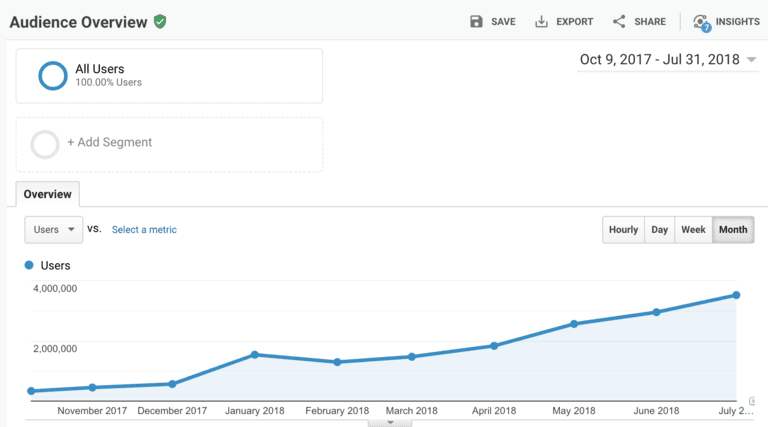
Whereas the same uplift for revenue took just over 12 months to achieve.
Middle of Funnel
Content marketing can act in two ways on the middle of the funnel (MOF) or the “consideration” stage:
- It can help prospects that are already in this stage continue their customer journey and take the next step by educating them;
- It can quickly pull double duty, drawing prospects in through the awareness stage into the consideration stage in the same session (i.e. they find your site through an organic search result to a content page, and sign up for an email incentive on that piece of great content).
Middle of funnel marketing metrics include:
- Email subscribers
- Leads
- Freemium user signups
- Demos booked
- Clickthrough rates
Bottom of Funnel
The bottom of the marketing funnel, or the “conversion” stage, is where the sale happens.
Bottom of funnel metrics include:
- Conversion rate (CR)
- Average order value (AOV)
- Revenue
- Orders
- Revenue per visitor
Content marketing doesn’t tend to get full credit for bottom-of-funnel metric improvements, but in reality, it makes these conversions possible.
If you don’t bring qualified traffic to your site you can’t retarget or remarket to those people and convert them.
This screenshot of one of my client’s attribution channels, using Google Analytics’ Model Comparison tool illustrates my point.
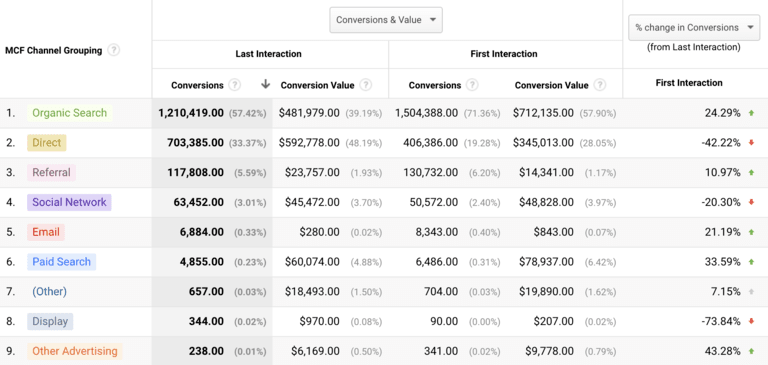
The Organic Search channel is mostly blog content. Only 57% of Last Interaction conversions are attributed to content.
When you look at First Interaction, however, it’s responsible for 71%.
This is because content marketing brought in most of the company’s traffic (organic search and much of the referral traffic).
We then continued to engage the visitors that didn’t convert on the first session through either retargeting with Facebook ads (Social Network in the channel groupings in the screenshot) or remarketing via email.
Examples of Content Marketing Strategy Goals
Here are some common examples of goals at each stage of the marketing funnel:
Top of Funnel
- Increase website traffic through publishing and promoting content weekly by:
- 50% within 6 months
- 100% within 12 months
- 200% within 24 months
- Achieve search engine ranking for keyword targets on each piece of content by:
- Page 3 within 9 months of publishing
- Page 2 within 12 months of publishing
- Page 1 within 24 months of publishing.
Middle of Funnel
- Grow email subscriber list through email incentives in each piece of content by:
- 10% in 4 months
- 20% in 8 months
- 30% in 12 months.
- Fill the sales team’s calendars with demo bookings by:
- 10 demos in 30 days
- 20 demos in 60 days
- 40 demos in 90 days
Bottom of Funnel
- Increase orders by:
- 10% within 6 months
- 20% within 9 months
- 100% within 12 months
Begin with the end in mind to ensure you have a clear view of the desired outcome of your content.
After you’ve set goals for your content strategy, the next step is to get specific about who you’re aiming to attract through your content.
Step #2: Define Your Target Audience

When you know who you’re targeting, it will help to ensure you’re setting the right tone and message, one that resonates with the things they care about or resolves the challenges they face.
Everything from the keywords you’ll target to the brand voice and language you use, and even the format and medium (e.g. blog post, visual content, social media content) you choose for your content should come from knowing your audience.
You may have a general idea of your target audience, but unless you understand not only their demographics but also their psychographics and behaviors, you’ll be shooting in the dark when developing your strategy.
The following two exercises will help you understand exactly who your target audience is so you can develop a content strategy that’ll attract, engage, and convert the right people.
Develop Buyer Personas
Creating buyer personas is key to attaining a clear understanding of your audience.
A buyer persona, also referred to as a customer avatar, is a fictional character rooted in customer research that represents your target customer. Buyer personas help to put a face and name to the potential customer and humanize them.
How to Create a Persona
If you haven’t created a buyer persona yet, it may sound daunting. But good news: all the information you need is at your fingertips through social listening.
Look through social media and communities to do some social listening.
Check out:
- Reddit: Spend some time reading through popular posts on relevant subreddits in your niche;
- Facebook groups: There are hundreds of thousands of conversations going on inside relevant Facebook groups that you can listen in on;
- Forums: Believe it or not, forums still exist in some interest groups and they can be a rich platform for social listening.
When you’re going through the posts on these social platforms, take note of the:
- Demographics of the community members (age, gender, location);
- The desires, goals, and fears of the people in the community as it relates to your product, what problems they are trying to solve and how they talk about them, and what type of lifestyle the average user leads. These are referred to as “psychographics.”
These will help you develop an understanding of the archetype of the person you want your content to attract. Once you’ve gathered some information, it’s time to get creative and create the persona.
This process is like creating a character in a video game and can be enjoyable!
To get started, gather these fundamental pieces of information about your target audience:
- Age
- Gender
- Family
- Profession
- Income
- Demeanor
- Unique challenges
If you’re artistic, create an illustration of the person you’re creating. If not, find a stock photo that accurately represents the persona.

The idea is to create a profile of that fictitious individual to put a face to the concept.
Businesses will often build several personas if they target more than one user type, but even starting with one will help you create a solid content strategy.
Empathy Map
Now that you have a buyer persona created, it’s time to put yourself in your customer’s shoes.
The empathy map is an effective tool for capturing knowledge about a person’s thoughts and behaviors.
There are many different variations of empathy maps you can pull from Google images. Here are some of the basic questions you are looking to answer about your buyer:
What does your persona:
- Think and feel: fears, hopes, dreams, and motivations
- Hear: influences their decision making & opinions
- See: environment, aesthetics
- Say & Do: typical day, actions, behaviors
- Pains: obstacles, frustrations, problems, challenges
- Gains: goals, needs
After you’ve built a profile using these two methods, you will have a deeper understanding of your customer.
Create all of your content considering this individual’s demographics, goals, wants, needs and desires. Although this persona you created is imaginary, this process will guide you in speaking directly to your targeted audience.
Step #3: Select Your Content Categories
You’ve set goals for your content marketing strategy.
You know exactly who your strategy is being built for.
Now, you need to determine the broad categories of your content.
The sweet spot for any content strategy is where audience interest and pain points meet the product’s value proposition.
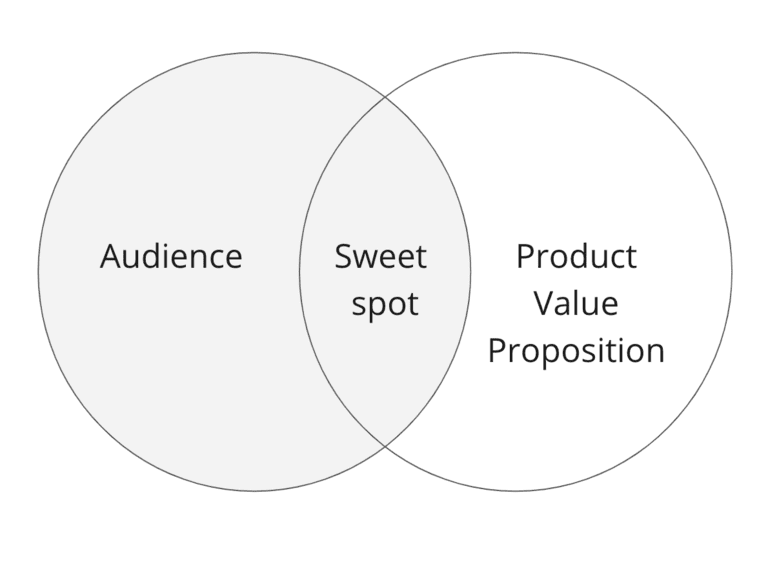
The categories you choose should fall naturally from your business and product offerings.
For example, at FLIGHTFUD, we’ve selected three broad categories for our content: Destination Guides, Aviation Industry, and Business Travel.
This isn’t arbitrary. These categories came from our three primary groups of customers, or buyer personas:
- Leisure travelers (Destination Guides)
- Aviation employees like flight attendants and pilots (Aviation Industry)
- Frequent business travelers (Business Travel)
For my client Retreat Guru, I selected four categories based on the most popular retreat types: yoga, meditation, wellness, and psychedelics such as ayahuasca.
There’s plenty of content that could be created surrounding other topics like couples retreats, but it wouldn’t fall within our content sweet spot.
Once you’ve nailed down your content categories, you can begin to map out the content plan.
Step #4: Map Out Your Content Topics
Finally, the step that most people think of when they set out to create a content strategy: content topics.
Finding ideas for content can be challenging, but in this section you’ll learn how to find enough topics to fill your editorial calendar for a whole year.
A well-built content marketing strategy builds in content topics for every stage of the marketing funnel: Awareness, consideration, conversion, and retention.
Brainstorm Topics
To start, put fingers to keys and begin noting every content topic that comes to mind when you think of your target audience and content categories.
For example, one of the categories for my site Adventure Baby is traveling with kids. In just a few minutes I was able to come up with several ideas:
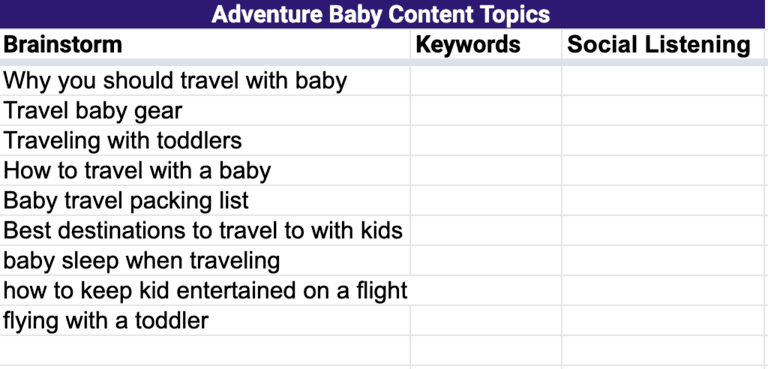
This is the brainstorming phase, so note whatever comes to mind. Don’t edit yourself yet.
Keyword Research
Keyword research is not only an SEO activity. It can also be a powerful idea generator for content creation.
To do this step, you need a keyword research tool. You can use KeywordTool (free) and Ahrefs (paid) to get started.
Begin searching for a few broad terms that are related to your niche and the categories you selected. For example, I used Ahrefs to search “traveling with baby”:
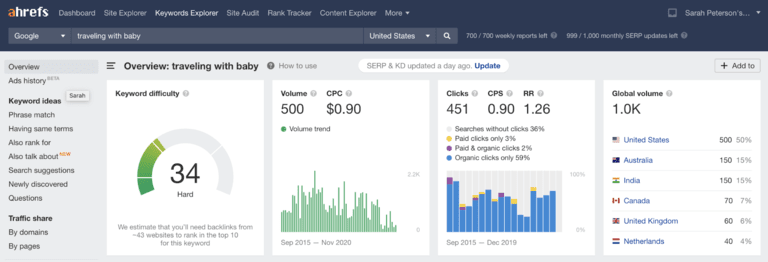
Almost all keyword research tools will have a suggestions section.
On the same page in Ahrefs, I scrolled down to find Keyword ideas by search volume.

I’ll populate my spreadsheet with all of these terms that have search volumes above 100 searches/month.

Explore Existing Content
This little-known trick can be a gold mine for material.
Exploring the existing content in your niche can be used to your advantage to get content ideas for any topic, or even find broken or outdated pages and recreate the content with up to date information (and then ask those who are linking to the page to link to your new and updated page instead).
You can do this by using a tool like BuzzSumo or Ahrefs Content Explorer to find the most popular existing content:
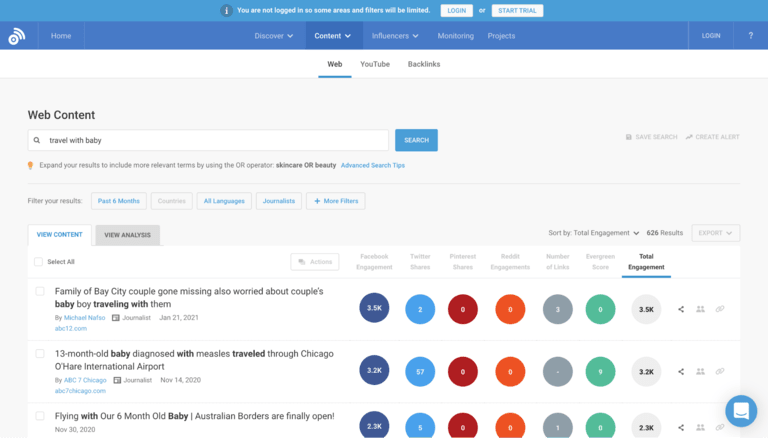
And use the results to inspire your own ideas.
Listen in Online Communities
Social listening is back again, but this time for content topic generation!
Find online forums or communities (the same ones you used to develop your buyer persona) of people interested in the topics you are basing your content around.
Don’t just skim the surface – read into the threads and comments. This is the perfect opportunity to get inside the head of your potential buyer and answer some key questions.
- What topics are they discussing?
- What problems do they have?
- What type of content are they already consuming?
Each one of these posts is a topic idea straight from the minds of my target audience.
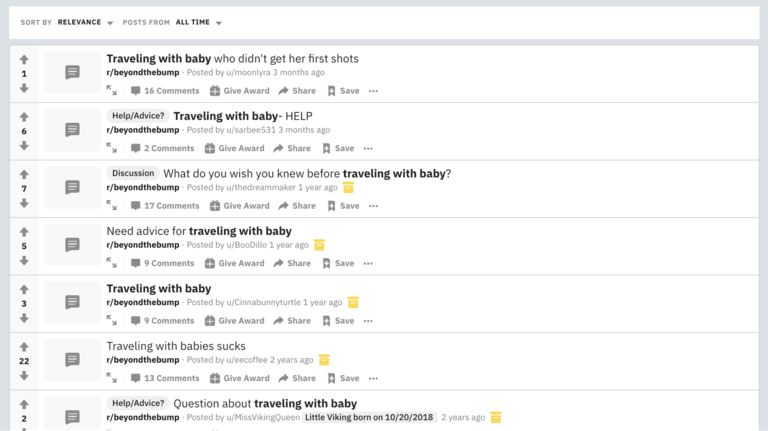
Add the relevant posts to your list:

If you spend a few hours on the above idea generation steps, you should have dozens of topic ideas.
Now you need to map them out.
Step #5: Develop a Content Calendar
After you have topics in each of your categories, you’ll need to slot them into your content strategy by creating an editorial calendar.
This is where you’ll schedule your content, so you know what is coming up and when it needs to be published.
Build out a visual workflow to assist in managing your content and release schedule. There is no one-size-fits-all format for this, but content marketers tend to use either a Google Sheet (affiliate link), CoSchedule, or a project management tool like Asana.
Having a visual will ensure you stay on track to meet your targets and goals for your strategy.
Step #6: Build Your Content

Now that you’ve got some ideas, you’ll need to determine the content type(s) you will focus your efforts on creating and developing your content.
There are many different types of content, including:
- Written
- Visual
- Audio
- Video
Peruse some content marketing examples to see some in action.
Use the previous steps (including the buyer persona profile you built) to determine which type of content resonates the most with your potential customers.
For example, if your target demographic is younger, they may prefer video over other forms of content.
This will usually vary depending on the specific content piece you’re developing — certain pieces are better in written form, some better as visuals — but you should have an idea of what formats you’re aiming to build into your strategy overall.
After you’ve selected the topics, mapped out your editorial calendar and chosen a format for each piece, it’s time to start developing the content.
Step #7: Create a Promotion Playbook

Most people spend hours planning their editorial calendars, crafting a piece of quality content and polishing it to perfection.
Then they’ll hit “publish” and sit back, waiting for the traffic, leads, and sales to roll in.
When the content doesn’t get any traction, they throw their hands up and declare defeat: content marketing no longer works, they assume.
The problem?
They haven’t spent any time distributing the content they worked so hard to create. Nobody knows the content exists.
To avoid falling into this common trap, your content marketing strategy needs a promotion playbook.
A promotion playbook is a plan that outlines how you plan to distribute your content to get it in front of your target customer.
The following content distribution channels should make it into your playbook so your content gets the attention it deserves.
One thing is certain, email isn’t going anywhere. With over 4 billion email users in 2021, email is the single most powerful tool in your arsenal to reach your audience.
It’s also one of the most cost-effective content promotion strategies available.
Share your content in a weekly content newsletter, and work your evergreen pieces into your email sequences. This will help your existing audience find your content and share it with their friends.
Organic Social Media
A key piece of any solid content strategy, social media offers an opportunity for content creators to find and attract potential customers and build brand awareness.
This comes as no surprise as over 3.6 billion people worldwide were using social media in 2020, with expected growth to 4.4 billion by 2025.
There are dozens of popular social media platforms to choose from, including:
- Twitch
- Snapchat
- TikTok
Focus your content promotion efforts where your audience spends their time.
For example, Snapchat and TikTok are most popular with younger demographics.
This makes it a prime tool if your buyers are teens or millennials, but a platform you should avoid if your buyer persona is a baby boomer or Gen X.
Paid Social Media
Although you may have built a killer email campaign and strong organic social media following, paying for social media exposure can be a powerful way to reach potential customers who are not already on your list of followers.
This can also help kickstart your organic following through shares and comments.
Most social media platforms, like Facebook and Instagram, allow you to set specific demographic parameters to ensure your precious ad money is getting your message in front of the right crowd.
Influencers
Influencers can engage your audience in a way not possible through traditional forms of advertising: from a trusted source in a casual setting.
This method of advertising comes across as authentic and can break down barriers between you and your potential customers.
Reach out to influencers in your industry to help you promote your content.
Some, especially if they’re not already aware of your brand, will ask for a sponsorship fee to share it.
The return on investment for this method can be substantial, and you may be surprised to find that some of the rates you receive from these influencers can be quite reasonable.
If your brand already has some clout, you may also be able to find ways to benefit both parties through cross-promotion.
Organic Search
SEO (search engine optimization) is the process of driving organic (free) website traffic from search engines.
Organic search was responsible for more than 50% of all site traffic in 2020, making it the most valuable weapon in your distribution and lead generation arsenal.
Optimizing your content for SEO is both art and science, but at its core means providing truly valuable and trustworthy content that satisfies the intent of the searcher.
By doing keyword research in Step #4, you’ve already taken the first step to driving traffic through organic search, so you just need to ensure that you optimize each piece of content for search engines (and avoid costly SEO mistakes).
Pay Per Click
Another useful method to kickstart your content is through a PPC campaign.
Google estimates for every $1 a company spends on PPC Google Ads, they receive $8 in profit, making this one of the most critical components to your digital marketing strategy.
Additionally, when a user clicks on an ad they’re more likely to make a purchase than if they come from another channel.
This method should be used only on landing pages where you are looking to encourage a purchase or transaction of some sort.
Once you’ve topped your content marketing strategy off with a repeatable promotion playbook, all that’s left to do is start content marketing.
Launch Your Content Marketing Strategy Today
Content marketing, when done correctly, can propel your business to heights you never thought possible.
The basic premise is simple: to build valuable content to maximize your traffic, and in turn extend your reach to potential buyers by increasing trust, and becoming the authority in your industry.
Begin with your goals and work your way through the step-by-step list provided above, you’ll be surprised at how quickly you make progress.
The post How to Create a Content Marketing Strategy in 2021 appeared first on Smart Blogger.

No comments:
Post a Comment